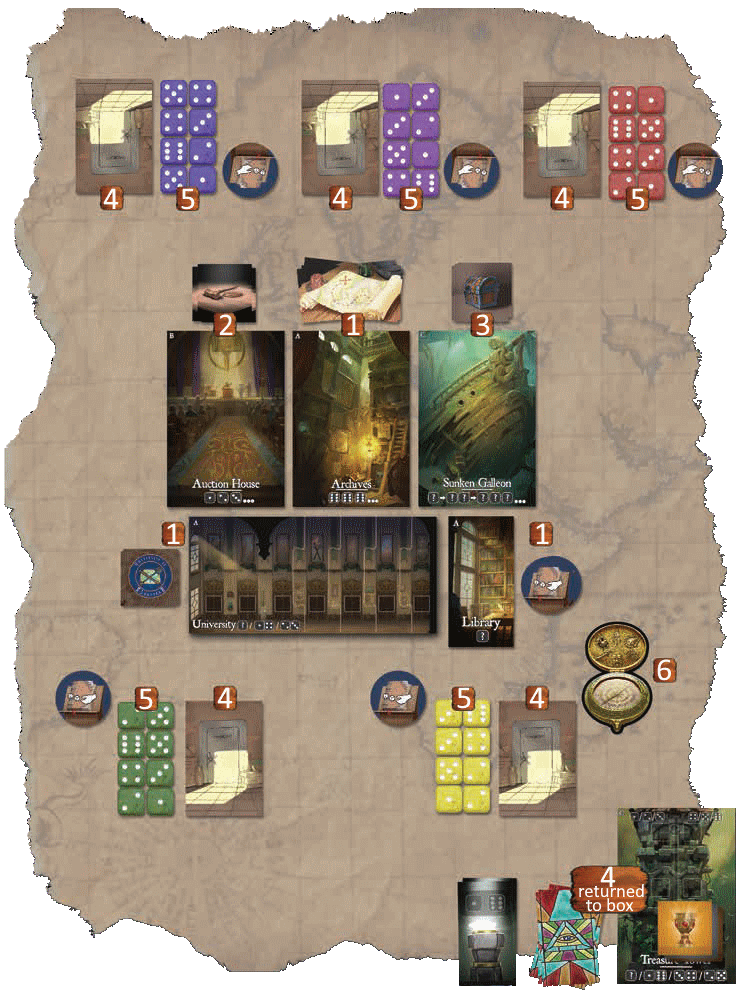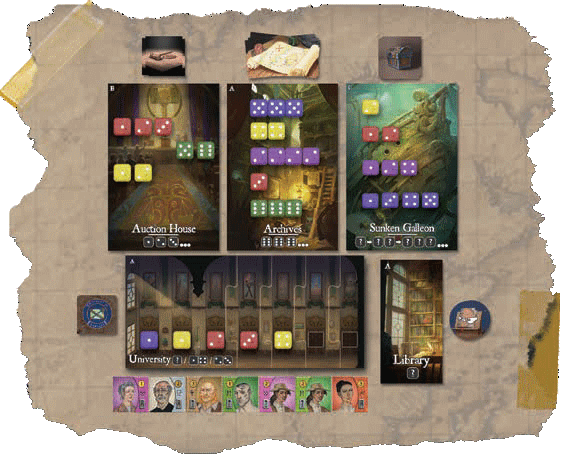If you are reading these rules for the first time, ignore the text along the right hand side. These rules serve as a summary to help you quickly familiarize yourself with the game.
Order of the Gilded Compass uses a variable setup in order to create fresh and interesting
gameplay experiences. Each game will use all three of the “A” buildings, and then a players’ choice of
one “B” building and one “C” building. This process of selecting and setting up the game for each play
is described in detail below.
-
The University, Archives, and Library buildings are called “A” buildings and must be
used every game. Set these buildings in the middle of the table as shown below. The
University should be assembled based on the number of players. Put the pieces together
to create a 4-space University with two players, a 5-space University with three players, a
6-space University with four players, and a 7-space University with five players. Next, shuffle
the specialist tiles face down and place them in a pile to the left of the University. Then,
shuffle the Ancient Map tiles and place them face down above the Archives. Finally, place
the knowledge tokens next to the Library.
-
Choose a “B” building (either the Treasure Hunters’ Guild or the Auction House) and
place it to the left of the Archives as shown below.
-
Choose a “C” building (the Hidden Temple, the Illuminati, the Sunken Galleon, or the
Treasure Tower) and place it to the right of the Archives.
-
Set up each of the buildings in play as described in the building descriptions.
Return any unused buildings and their associated tiles to the box.
-
Give each player eight dice of his chosen color to be placed in his play area along with
one knowledge token.
-
Give the start player marker to the player who has most recently found something
valuable. (Alternatively, players may randomly determine the start player.)
You are now ready to begin playing.

In the above setup, each player has a private collection tile as they
are playing with the Auction House. In a setup without the Auction
House, players would have no such tile at the beginning of the game
and would instead simply begin with dice of their color.
-
Play 6 rounds if 2-3 players, 5 rounds if 4-5 players.
-
Players take turns in clockwise order.
A turn consists of rolling all of one's unplaced dice then placing one or more of them
on a single building.
-
A round ends when at least one player has placed all of his dice and all players have
taken the same number of turns.
-
At the end of a round, unplayed dice are moved to the Library and buildings are resolved one at a time.
Buildings give various rewards to the player(s) who best meet their conditions.
-
After all buildings have been resolved, players retrieve their dice and the next player
in clockwise order starts the next round.
-
All scoring is done after the last round. The player with the most gold (points) wins.
Order of the Gilded Compass is played over six rounds with 2-3 players or five rounds with 4-5 players.
At the beginning of a round, the player with the start player marker takes the first turn. A turn
consists of rolling all of one's unplaced dice then placing one or more of them on a single building where they
will remain for the rest of the round. Each building has unique rules governing the placement of
dice as described later in these rules.
After the first player has placed his dice on a building, the next player in clockwise order takes
his turn by rolling and placing dice. (Note that a player rolls all of his unplaced
dice at the beginning of each of his turns, not only his first turn of a round.)
Continue taking turns in clockwise order until the end of the round.
Once a player has placed all of his dice, the round will end when all players have taken the same number of
turns. I.e., the round ends when the player to the right of the start player completes his turn and at least one
player has placed all of his dice.
At the end of a round, players move any unplayed dice they have to the Library.
Then the buildings are resolved one at a time, left to right and top to bottom. The
player(s) who best meet the conditions of each building will gain that building’s rewards. These
conditions and rewards are described later in these rules.
After all buildings have been resolved, players retrieve their dice and the start player marker is
passed one player clockwise. Then, a new round begins. This is repeated until either five or six rounds
have been played depending on the number of players. Then, players proceed to game end and final scoring.
After final scoring, the player with the most gold is declared the winner!

Special Ability Tiles
A Timely Gift (x5):
Take an additional turn after the round ends if you have at least one non-neutral die.
(Use after round ends. If multiple players have “A Timely Gift”,
the choice to use them begins with the start player and goes clockwise.)
Multiple players may use “A Timely Gift” during the same round. A player may use only one
“A Timely Gift” per round.
The Will to Win (x5):
Place an identical set of dice, creating a tie, in the Archives, Auction House or Treasure Hunters’ Guild.
Then move one of your opponent's dice from the tied set to the Library.
Removing the opponent's die must not create a set that is not unique or,
in the cases of the Auction House or Treasure Hunters’ Guild, a set that is not a sequence.
On Yucata the "opponent" can be the neutral player, and The Will to Win can be used when
placing neutral dice.
A Little Help (x5):
Gain 2 extra dice.
(Use at start of your first turn of a round. Only one player per round may use this ability.)
A Compelling Power (x5):
Set two of your dice to your desired results.
(Use immediately after rolling.)
A player may use only one “A Compelling Power” per turn.
On Yucata one or two of the dice can be neutral dice.
Variant 2 - Neutral Player
This variant allows for use of more variety in buildings and sometimes increases direct
interaction between players.
At the start of the game, designate one color of dice as “The Neutral Player”. Give each human
player two dice of the neutral player’s color to be added to his own. On a player’s turn, he
rolls all of his dice (including neutral dice). A player may place one or more of his neutral
dice in a building during a turn before or after placing his own dice. Neutral dice must follow the normal
placement rules, i.e., they may only be placed in a single building per turn and must
follow the rules of the building they are placed in. A player may choose not to place neutral
dice during a turn.
The neutral dice act as a single extra player, meaning that in subsequent turns any player may
add dice to a neutral set already in a building.
A player is considered to have used all of his dice (and triggered the end of the round) when
all of his own dice have been placed whether or not he still has any neutral dice.
When the neutral player wins a building reward, the reward is discarded.
When a choice is required, the neutral player takes the highest
value reward with ties being broken top to bottom and left to right. If a reward would generally
be kept secret, it is treated as though no one claimed that reward. The specific rules for the
various buildings are as follows:
"A" Buildings
Archives:
Neutral Winner: Discard the highest value Ancient Map tile remaining. Ties are broken top to bottom.
Library:
Neutral Winner: No effect.
Since placing a neutral die in the Library can never benefit a player, doing so is not allowed on Yucata.
Neutral dice that would otherwise be moved from another building to the Library are discarded.
University:
Neutral Winner: Discard the highest value specialist tile remaining. Ties are broken left to right.
"B" Buildings
Auction House:
Neutral First Place Winner: Discard four random tiles face up.
On Yucata discard three random tiles face up rather then four.
Neutral Second Place Winner: Discard two random tiles face up.
Neutral Third Place Winner: Discard one random tile face up.
Treasure Hunters’ Guild:
Neutral First Place Winner: Second place winner draws only two tiles.
Neutral Second Place Winner: Randomly choose and discard one of the two passed tiles face down.
Neutral Third Place Winner: Discard the passed tile face down.
"C" Buildings
Hidden Temple:
Neutral Winner: Tile is returned face down to the supply.
Illuminati:
Neutral First Place Winner: Discard the topmost tile.
The second place winner chooses one of the remaining tiles to keep and discards the other.
Neutral Second Place Winner: The first place winner takes one tile,
discards the topmost remaining tile, and takes the final tile.
Sunken Galleon:
Neutral First Place Winner: All players with a set keep one tile.
Neutral Other Place Winner: No effect.
(Note: These Sunken Galleon rules are a correction by the designers to the published rules.)
Treasure Tower:
Neutral Winner: No tiles are drawn for the neutral player.
Agents of the Illuminati are everywhere. Befriending those in key locations could prove to be a huge advantage.
Setup:
Mix the four “An Ally Inside” tiles in with the other Special Ability tiles.
Gameplay:
The “An Ally Inside” tiles are collected in the same way as other Special Ability tiles.
They can be used at the end of a round in order to improve the resolution position of one of
your Archives sets by one.
For example, if you have the second highest set,
you may spend your “An Ally Inside” tile to treat it as the first highest set and therefore
pick an Ancient Map first. Similarly, if your set was 5th,
you can move it to 4th).
This Special Ability may be used at the end of a round before
the Archives begins to be resolved. If multiple players have “An Ally Inside”,
the choice to use them begins with the start player and goes clockwise.
Multiple players may use “An Ally Inside” during the same round. A player may use only one
“An Ally Inside” per round.
Rumors have surfaced about valuable goblets in the Treasure Tower split and scattered.
Find both halves of one of these legendary treasures and greater wealth will follow.
Setup:
Remove two of each of type of treasure tile at random (2 bronze, 2 silver, 2 gold)
and return them to the box without looking at them.
Then, mix the treasure fragment tiles in with the remaining treasures according to their backs.
Gameplay:
Treasure fragments are collected just like other treasures.
Each unmatched fragment is worth its printed value (0, 1 or 2) in gold at the end of the game.
However, if you collect a matching pair of treasure fragments
(e.g. both silver treasure fragments) they instead score as a pair as follows:
a bronze pair scores three gold, a silver pair scores five gold, and a gold pair scores 7 gold.
For example, if at the end of the game you have 1 bronze fragment, 2 silver fragments
and one gold fragment, they are worth seven gold (zero gold for the single bronze,
five gold for the silver pair, and two gold for the single gold).